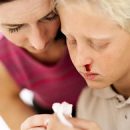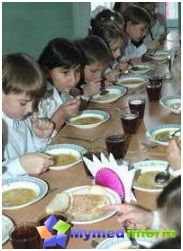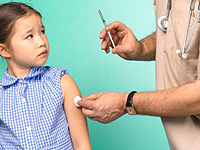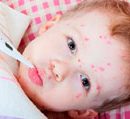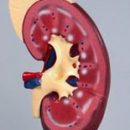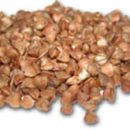Cheering against measles, rubella and vapotitis and possible reactions. Check out detailed information about the vaccination of children against measles, rubella and vapotitis, find out how to prevent complications.
Content
- Normal reaction to measles vaccination, rubella and epidemic parotitis
- Complications after vaccinations from measles, rubella and parotitis
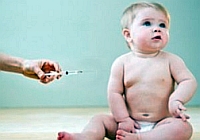 According to the national calendar of vaccinations in Russia, the vaccination of children against measles and epidemic vapotitis (pig) is carried out by the domestic drug, and an Indian remedy is introduced against rubella. Foreign preparation is purchased by the state for free vaccination of children. These vaccinations are held twice: aged one and six years. It happens that for any reason the child did not stick in time, then vaccination is transferred to adolescent age (13 years). When vaccination, the child put two injections: one — Divaccine against measles and vapotitis, and the second — against rubella. In addition to these vaccines, there are foreign drugs that combine three viruses in themselves.
According to the national calendar of vaccinations in Russia, the vaccination of children against measles and epidemic vapotitis (pig) is carried out by the domestic drug, and an Indian remedy is introduced against rubella. Foreign preparation is purchased by the state for free vaccination of children. These vaccinations are held twice: aged one and six years. It happens that for any reason the child did not stick in time, then vaccination is transferred to adolescent age (13 years). When vaccination, the child put two injections: one — Divaccine against measles and vapotitis, and the second — against rubella. In addition to these vaccines, there are foreign drugs that combine three viruses in themselves.
The beneficial effect of the vaccine is to form immunity to measles, rubella and epidemic parotitis due to the introduction of a child of these viruses into the body in weakened and unpactogenic form. Preparations used to vaccinate children from these diseases:
- L-16 — domestic agent against measles;
- «Ruvaks» — Foreign measles vaccine;
- MMP-II — Triple overseas vaccine;
- «Priorix» — Triple overseas vaccine;
- associated fault-core red vaccine;
- L-3 — domestic vaccine against vapotitis;
- associated measles and vapor divaccine;
- «Rudivax» — Foreign vaccine against rubella;
- «Ervevaks» — Foreign vaccine against rubella.
Basically vaccines are produced in dry form and require dissolution before applying.
Normal reaction to measles vaccination, rubella and epidemic parotitis
 Associated and monovaccines, as a rule, do not cause negative reactions in the body. In the first two days, a normal reaction may be observed, expressed in redness and swelling place of the injection. These symptoms will be held. Normal reactions to measles vaccine can manifest themselves after the fifth day and until the end of the second week in the form of temperature rise, runny nose and light shame. The consequences of anti-copy vaccination can be expressed as the same temperature rise, redness of the oz, runny nose and rarely increasing the parole. For a normal reaction to the vaccination against rubella, symptoms are characterized in the form of an increase in the body temperature of a child, a cold and swallowing, but, in addition, rashes may appear and increase lymph nodes. When vaccinating at a later age after the vaccination may appear in the joints. If such symptoms are observed after two weeks from vaccination, refer to the pediatrician (or therapist), it may be a symptom of a vaccine-related disease.
Associated and monovaccines, as a rule, do not cause negative reactions in the body. In the first two days, a normal reaction may be observed, expressed in redness and swelling place of the injection. These symptoms will be held. Normal reactions to measles vaccine can manifest themselves after the fifth day and until the end of the second week in the form of temperature rise, runny nose and light shame. The consequences of anti-copy vaccination can be expressed as the same temperature rise, redness of the oz, runny nose and rarely increasing the parole. For a normal reaction to the vaccination against rubella, symptoms are characterized in the form of an increase in the body temperature of a child, a cold and swallowing, but, in addition, rashes may appear and increase lymph nodes. When vaccinating at a later age after the vaccination may appear in the joints. If such symptoms are observed after two weeks from vaccination, refer to the pediatrician (or therapist), it may be a symptom of a vaccine-related disease.
Complications after vaccinations from measles, rubella and parotitis
Vaccinations can cause quite serious complications. These include:
- allergic reaction;
- damage to the nervous system (febrile cramps);
- Vaccinoassoic pathology.
Allergies often occur as reactions to additional vaccine components. They manifest themselves in the form of swelling and redness (≈8 cm) at the place of administration of the drug. Vaccination rarely causes serious pathology — HIV, AIDS, Korea Encephalitis. Parents should not panic and abandon the vaccination of the child: the percentage of these diseases in non-vaccinated children occurs much more.
The prevention of vaccine complications uses:
- Antihistamines: prescribed children prone to allergies;
- Tools;
- No contact with infected people.
If a child has acute disease or exacerbation of chronic disease, vaccination will have to postpone and spend only a month after recovery.


